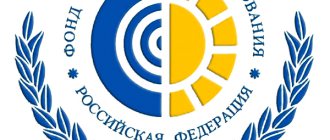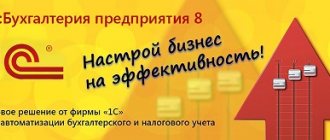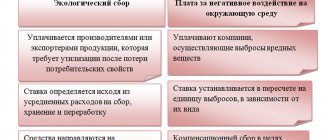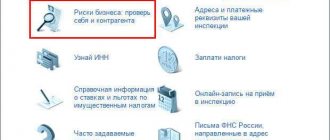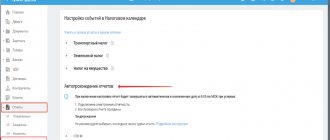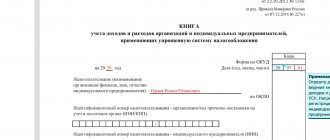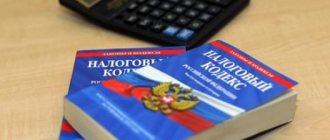When will you have to pay VAT on the simplified tax system?
The general provisions of the simplified tax system do not provide for the accounting and transfer of VAT. However, the Tax Code of the Russian Federation provides for cases when VAT will still have to be calculated :
- if there is a government order to be fulfilled or the counterparty under the construction contract is an organization located on OSNO
- supply of goods for the enterprise is carried out from abroad
- there are agreements of trust management, simple or investment partnership, provided that the counterparty is located on the OSNO
- if the company leases or buys property from municipalities
- the enterprise issued an invoice to the buyer using the simplified tax system with the allocated amount of VAT
Further, the topic in the article will be considered subject to construction work.
How to get a refund
It all starts with it - with the VAT return. To declare your claims to the budget, you first need to fill out a declaration and submit it to the tax office.
Along with the declaration, an application for VAT refund is also provided, indicating the details of your current account. To be honest, it is not necessary to submit an application along with a report, but this way the waiting period will be shorter.
Svetlana: “Having received a VAT return for reimbursement from the budget, inspectors face a difficult period, which can be divided into:
- stage of denial - this cannot happen, because it is the taxpayer who must pay taxes to the state, and not vice versa,
- stage of anger - how is it that when the whole country pays taxes, this taxpayer decided to take them away from the state,
- to the acceptance stage - since the taxpayer has such a right, then nothing can be done.”
In practice, there is one more stage: bargaining. This is when the tax inspector tries to agree with the taxpayer to remove “extra” VAT deductions and how to pay the tax to the budget. But you should not follow the verbal demands of the inspector. If the VAT return is filled out correctly and you are confident in your suppliers (in their invoices), then you should not retreat.
Before making a decision on a VAT refund, the tax authority will conduct a desk audit of the declaration. Usually it lasts up to 2 months, in some cases the period can be increased to 3 months.
During the entire period of the desk audit, the taxpayer should not relax because:
- inspectors can send the taxpayer a request to provide documents and explanations on the declaration, since the state must make sure that it will transfer the money into the hands of a law-abiding taxpayer (clause 3 of Article 88 of the Tax Code of the Russian Federation).
It should be remembered that if you trade for export, then documents confirming the VAT rate of 0% must be submitted simultaneously with the declaration.
- Tax authorities can come to visit and inspect your premises if inconsistencies are identified during the inspection.
Finally, everything is over and the inspection revealed no violations. Wait another 7 days until the head of the tax office makes a positive decision on the tax refund, and another 5 days until the treasury transfers the funds.
This is provided that you submitted a return application along with your declaration. If such an application was submitted after the decision on compensation was made, then you will receive the money a month after its submission (clause 11.1 of Article 176 of the Tax Code of the Russian Federation).
You also need to remember that before transferring the VAT amount to the current account, the tax authority will first pay off debts to the budget (if any) and only then transfer what is left.
VAT compensation
Compensation is a way that allows entrepreneurs on the simplified tax system to make transactions with organizations on the OSNO. With its help, you can take into account and deduct VAT, which was transferred by entrepreneurs to the simplified tax system when purchasing raw materials necessary to fulfill contractual obligations.
Joint activities of enterprises on the simplified taxation system and OSNO imply the presence of risk for both. In the case of “simplification”, the tax office may recognize the amount of the contract as unreasonable and reduce its value; for the general taxation system, there is a possibility that inspectors will refuse to apply a deduction that allows reducing the amount of tax to be paid to the budget.
In this regard, it is necessary to approach the issue of documentation very carefully. And also be guided by the following scheme of actions:
Scheme of actions of counterparties on the simplified tax system and OSNO
The estimate is the primary document when carrying out construction work. All planned work and the order of its implementation should be reflected here, as well as all possible costs. Further, it is on the basis of the approved estimate that acts and invoices will be signed.
VAT accounting with “simplified”
In accordance with the rules of the Decree of the Gosstroy of Russia dated March 5, 2004 No. 15/1, it is necessary to draw up local estimates. All planned expenses should be grouped depending on the type of work, equipment used and other conditions.
The amounts of all planned expenses, as well as profits, are taken into account without taxes.
An entrepreneur on the simplified tax system, acting as a contractor for construction work, usually bears the costs of purchasing consumables, fuels and lubricants, and makes payments to third-party companies for routine repairs of equipment.
An enterprise using the simplified tax system has one and only option for accounting for VAT in the estimate documentation: the total cost must be reflected without taking into account the tax, and the tax itself must be reflected in the line “Costs for VAT compensation under the simplified tax system,” which must be added in the chapter “Taxes and Mandatory Payments” of the section "Limits, costs."
Why can’t VAT be excluded from the estimate?
The fact is that, despite its prevalence, the simplified tax system is a special case of taxation practice. The largest enterprises, budgetary organizations and suppliers of basic resources, operate under the general taxation system ( OSNO ), many trade and service enterprises do the same. It is reasonable to assume that if there is a legal entity or entrepreneur using the simplified tax system, then the services that he himself receives from other organizations are, one way or another, subject to VAT. And you will still have to pay the bills, classifying them as expenses. It turns out that the amount of VAT for such an entrepreneur is included in the total cost of the goods or services.
Let's give a rough example: the cost of one brick in a trading company is 10 rubles. The VAT rate is 20%, the amount of VAT is 2 rubles.
- For a buyer working under OSNO, a brick will cost 10 rubles, VAT 2 rubles, total including VAT 12 rubles.
- For a buyer working under the simplified tax system, a brick will cost 12 rubles. . VAT is not allocated and cannot be refunded
But in estimates, VAT is accrued as a result (in limited costs), and in estimate items, the cost of materials (MAT) and operation of machines (EM) is indicated without VAT. This means the contractor will buy a brick for 12 rubles, and add a brick to the estimate for 10 rubles. By not charging VAT in the end, he loses 2 rubles. But he cannot charge VAT as a result of the estimate, because he is not the payer.
In this case, the contractor must be reimbursed for the VAT he paid. In limited costs, as a result of the estimate, “VAT” is replaced by . ”
From January 1, 2022, the value added tax is 20%. This change will be applied to all participants in economic activity, regardless of the terms of previously concluded contracts. Amendments have been made to the article and the formula for calculating VAT compensation. For details on accounting for the new VAT amount in invoices, see thematic collections of reference and legal systems and on the official website of the Federal Tax Service
Procedure for calculating the amount of compensation
To determine the amount of VAT compensation for enterprises using the simplified tax system, a special formula was developed:
Formula for calculating the amount of VAT compensation
Coefficients for overhead costs and estimated profit were developed specifically for enterprises using a simplified taxation system. They must be applied whenever determining the amount of VAT compensation, regardless of the type of work performed. When determining overhead costs, it is recommended to adhere to the instructions of MDS 81-33.2004.
The purpose of the estimate is to include the minimum amount of costs that are planned to be incurred in the course of the contractor fulfilling its contractual obligations. Even the cost of used office supplies can be included in overhead costs.
How to count
So, when drawing up an estimate for an organization that has chosen a simplified taxation regime, value added tax should be included. But in the calculation part of the document it will be incorrect to indicate the “VAT” column. Therefore, include a special section “VAT compensation under the simplified tax system” in the estimate.
But what to include in this field, because simply applying the current rate to the final cost of the work or service is wrong. At least there are at least three VAT rates: 0%, 10% and 20%
IMPORTANT!
From 01/01/2019, apply a new increased VAT rate of 20% instead of the old one of 18%. Take into account the provisions for all deliveries and shipments of goods that were made already in 2022.
Formula for VAT compensation under the simplified taxation system:
(MAT + (EM - ZPM) + HP × 0.1712 + SP × 0.15 + OB) × 0.20,
Where:
- MAT is the material costs of providing a service, performing work;
- EM - the sum of the costs of operating the machines;
- ZPM - wages and remunerations of drivers and other specialists operating machines;
- HP - overhead costs. For this category of costs, which can be included in the calculation of VAT compensation for the invoice in the estimate, a standard of 17.12% has been determined;
- SP is the company's estimated profit included in the calculation. There is also a limit set for this indicator - 15%;
- OB is the pure operation of equipment for the provision of services and work;
- 0.20 is the current tax rate. Previously, the figure was 0.18 (18% until December 31, 2018).
Indicate the received amount of compensation for VAT losses in a special section of the estimate documentation.
Required documentation for the counterparty on OSNO
To ensure that an organization using the general taxation system does not have problems with the tax inspectorate in the future when deducting the amount of VAT indicated in the estimate, the following conditions must be met:
- when purchasing consumables, fuel and other goods, a contractor using the simplified tax system must retain all invoices received from sellers
- Based on the received invoices, the enterprise issues its own on the simplified tax system, subject to certain rules, namely:
- the date of the original invoice must coincide with that issued by the contractor, and the number is affixed in accordance with the numbering of the enterprise on the simplified tax system
- in the seller column the actual seller who sold the goods is indicated, and in the line the buyer is an organization on OSNO, the new invoice is signed by the seller on the simplified tax system
- the “simplified” contractor must give to the customer organization on OSNO both the original invoices received from the sellers of consumables and those issued by himself
- at the end of the quarter, the enterprise, using the simplified tax system, fills out a special journal for recording issued and received invoices and submits a corresponding declaration to the tax office, while tax remittance is not required
If the contractor for the simplified tax system and the customer for OSNO adhere to these rules, this will save them from questions and misunderstandings from the tax authorities, and will allow them to freely receive the required deduction for value added tax.
Formula for VAT compensation under the simplified tax system in the estimate. Counting example
If you look at Figure 1, you can see an example of calculating VAT under the simplified tax system in estimates in 2022, as well as in the year 2022. This calculation is based on the example from the attachment of the above letter.
Figure 1. Example of calculating VAT compensation in estimates for the simplified tax system
As you can see, the calculation has three columns, each of which indicates the necessary data for calculating a sample estimate without VAT under the simplified tax system. The first column indicates cost items. According to the methodological document in construction MDS81-35.2004, the items of estimated costs include the following categories: the cost of materials, operation of machines and mechanisms, as well as the cost of the wage fund (WF), which constitute direct costs in the estimate. The wage fund is the summation of workers' wages and drivers' wages.
Plus, as part of the estimate forms, there are enlarged standards for overhead costs (OS) and estimated profit (SP), which are also components of the estimated cost items. By the way, letters from the State Construction Committee and the Ministry of Justice also recommend reducing coefficients for the norms of NR and SP under the simplified tax system, which will be discussed further in the text.
In addition to those listed above, the cost of paying taxes is included in the estimate form, and various limited costs, costs for unforeseen expenses, etc. can also be listed.
However, the purpose of the simplified tax system in the estimate is that, as noted above, many taxes cannot and should not be reflected in the estimate form due to the tax regime. Therefore, for taxes such as VAT on materials under the simplified tax system in the estimate, a calculation is provided similar to that illustrated in Figure 1. Thus, it becomes clear how each of the cost items in the first column of the calculation is deciphered in the estimates of the simplified tax system.
The second column in the example of calculating the simplified tax system in the estimate contains the spontaneous cost of work, which is measured in thousands of rubles. And in the third column, calculations are made for reimbursement of VAT costs under the simplified tax system in the estimate. For convenience, all simplified taxation formulas in the estimate in Figure 1 are described in detail, however, in a real estimate they can be indicated immediately in the totals.
So, in order to calculate the amount of VAT compensation under the simplified tax system in the estimate, you should first find out the amount of value added tax for each cost item. So, if you turn to the line “Materials”, the amount of which, indicated in the second column, is equal to 5000 thousand rubles, you can calculate the amount of VAT in the amount of 20% in the following way: 5000 multiplied by 20%. The result is 1000 thousand rubles.
Workers' wages remain unchanged, since VAT is not paid on them. But regarding the costs of operating machines, the same principle applies as when calculating VAT in estimates under the simplified tax system for materials.
However, it should be taken into account that the operation of machines must be taken into account in this calculation in its pure form, that is, without the cost of machine operators’ salaries. Therefore, the simplified tax system formula in the estimate in this line is given as follows: the driver’s salary “350” is deducted from the amount of operation of machines “1800”. Next, an identical calculation is made, that is, the amount of VAT is calculated. In this case it is 290 thousand rubles.
The “Total” line shows the amount of VAT on materials and mechanisms, which is taken into account in the simplified tax system estimate: 1000+290 =1290.
The next step in calculating VAT compensation in the estimate is calculating the tax as part of overhead costs and estimated profit. Since HP and joint venture in the estimate are calculated on the basis of payroll, calculations will be made from the sum of the salaries of workers and drivers, that is, from 1900 + 350 = 2250 thousand rubles.
As you can see, coefficients of 1.18 and 0.7 are also applied to the overhead cost indicators in the estimate. The coefficient of 1.18 is included in the calculation based on Appendix 2 of MDS 81-4.99 and is an aggregated standard in housing and civil construction for this type of standard. Also, the simplified tax system formula in the estimate in the HP part contains a reduction factor of 0.7, which will be discussed further in the text in the corresponding paragraph.
Thus, it turns out that the amount of overhead costs for calculating the VAT refund under the simplified tax system in the estimate in Figure 1 is 1858.5 thousand rubles. To this amount, an indicator of the specific weight of materials costs in the amount of 0.183 is applied, and the amount of VAT of 20% is also calculated.
In relation to the estimated profit indicator, similar calculations are made for reimbursement of VAT costs under the simplified tax system in the estimate. However, the aggregated standard indicator is excluded from the formula. Instead, the calculations must include the industry-wide SP standard, applied on the basis of MDS81-25.2001. In addition, the specific gravity of materials for the estimated profit is 0.15 and must also be taken into account in the final calculation.
After making all the calculations, you need to display the total amount for all lines. In the example in Figure 1, this is 1397.57 thousand rubles. Thus, VAT compensation under the simplified tax system in the estimate in this case will be 11.43%.
